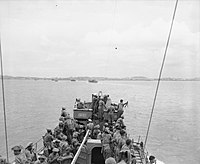Military history of India
The predecessors to the contemporary
History of science and technology in the Indian subcontinent |
| By subject |
|---|
|
The armed forces succeeded the
-
Indian warrior in Armor by Edwin Lord Weeks.
-
Ancient Indian Antennae sword; Metalwork, 1500–500 BCE.
-
Ancient Indian Ax Blade, 1500–1000 BCE.
Indus Valley Civilisation
Fortified cities have been excavated from the
An Indus seal depicting a soldier firing a composite bow was unearthed in Shortugai, Afghanistan, which indicates that Indus people were already familiar with it long before they were depicted in ancient Indian reliefs. Another copper seal from Mohenjo Daro shows a horned hunter holding a composite bow.[5]
-
Defensive wall ofGujarat, India, 2650 BCE.
-
Rajasthan, India, 2500 BCE.
The Vedic and Mahajanapada period
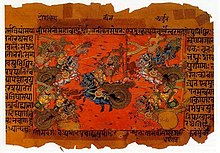
An excavation at
The
The


The two great epics of Hinduism, the Ramayana and the Mahabharata, center on conflicts between the emerging Mahajanapadas and refer to military formations, theories of warfare and esoteric weaponry. They discuss standing armies that used in war chariots, war elephants and even mythical flying machines (vimana). The Ramayana describes in great detail the fortifications of Ayodhya. The Mahabharata describes various military techniques such as Chakravyuha used in the Kurukshetra War.
The Indian dynasties
Shaishunaga dynasty
The
Nanda dynasty
The
In 327 BC
Maurya Empire
According to Megasthenes, who served as an ambassador from the Seleucid Empire, Chandragupta Maurya built an army consisting of 30,000 cavalry, 9,000 war elephants, and 600,000 infantry. Chandragupta conquered much of Indian subcontinent, establishing an empire from the Arabian Sea to the Bay of Bengal. He then defeated the Hellenistic Seleucid Empire under Seleucus I Nicator to conquer the regions to the west of the Indus River. He then turned south, taking over much of what is now Central India. His military was administered by six chairs, one for each of the four arms of the army (infantry, cavalry, elephants, and chariots), one chair for the navy, and one for logistics and supply.
Infantry at this time was most commonly armed with a longbow made of bamboo and a single- or double-handed broadsword probably similar to the khanda. Other foot soldiers could be armed with a large animal hide tower shield and a spear or javelins. Cavalry carried lances. Elephants were mounted, sometimes allegedly with howdahs, which may be an Indian invention[9] by archers or javelin throwers, with a mahout around the animal's neck. Chariots by this time were in definite decline, but remained in the army due to their prestige.
In 185 BCE, the last
Shunga Empire

War and conflict characterized the Shunga period. They are known to have warred with the Kalingas, Satavahanas, the Indo-Greeks, and possibly the Panchalas and Mathuras.
Extent of the Shunga Empire's wars with the Indo-Greek Kingdom figure greatly in the history of this period. From around 180 BCE the
The Indo-Greeks and the Shungas seem to have reconciled and exchanged diplomatic missions around 110 BCE, as indicated by the Heliodorus pillar, which records the dispatch of a Greek ambassador named Heliodorus, from the court of the Indo-Greek king Antialcidas, to the court of the Shunga emperor Bhagabhadra at the site of Vidisha in central India.
The Golden age
Classical Indian texts on archery in particular and
Satavahana dynasty
According to some interpretations of the
Mahameghavahana dynasty
The
The Kharavelan state had a formidable maritime empire with trading routes linking it to Sri Lanka, Burma, Thailand, Vietnam, Cambodia, Borneo, Bali, Sumatra and Java. Colonists from Kalinga settled in Sri Lanka, Burma, as well as the Maldives and Maritime Southeast Asia. Even today Indians are referred to as Keling in Malaysia because of this.
The main source of information about Khārabeḷa is his famous seventeen line rock-cut Hātigumphā inscription in a cave in the Udayagiri hills near Bhubaneswar, Odisha. According to the inscription, he attacked Rajagriha in Magadha, thus defeating the
Gupta dynasty
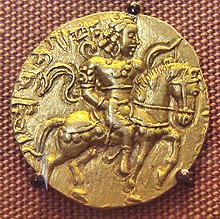

Siva-Dhanur-veda discusses the military of the Gupta Empire. The Guptas relied less on armoured war elephants compared to previous Indian empires. The use of chariots had declined heavily by the time of the Guptas, as they had not proved very useful against the Greeks, Scythians, and other invaders. Guptas utilised famously used cavalry archers, and it became the prestige arm of the military as evidenced by coinage. Heavy cavalry clad in mail armour and equipped with maces and lances would have used shock action to break the enemy line.
They also employed infantry similar to previous periods: Archers with a longbow composed of bamboo or metal and fired a long bamboo cane arrow with a metal head; iron shafts were used against armoured elephants. They also sometimes used fire arrows. Archers were frequently protected by infantry equipped with shields, javelins, and longswords. The Guptas also maintained a navy, allowing them to control regional waters.
4th century CE Sanskrit poet Kalidasa, credits
The Classical age
Empire of Harsha
Emperor
The Chalukyas and Pallavas
In
The Pallava king
The Chola Empire
The
The Gurjar-Pratiharas, Palas and Rashtrakutas
The Arab scholar Sulaiman described the emperor of the
There were many battles between the Gurjar Pratiharas under Bhoj and the
Al-Masudi wrote that in 915, during Mahipala's rule, the Pratiharas were at war with the Muslims in the west and the Rashtrakutas in the south, and that the Gurjar Pratiharas had four armies of about 80,000 men each.
Arab conquest of Sindh
In 712, an Arab general, named Muhammad bin Qasim Al-Thaqafi (Arabic: محمد بن قاسم) (c. 31 December 695 – 18 July 715), attacked and conquered
Indian inscriptions confirm this invasion but record the Arab success only against the smaller states in
In the early 11th century,
The Medieval era

Delhi Sultanate
The
The Rajputs
After Babur's victory over Ibrahim Lodi, the
In the
Muzaffarid dynasty

Sultan Muzaffar Shah I, the governor of
Calicut
Ruled by the
Vijayanagara Empire
The Italian traveler Niccolo de Conti wrote of the Emperor of the
Between 1512 and 1514, Krishnadevaraya subjugated the Palaigar of
On 26 January 1565, the neighboring kingdoms of
Later, the Vijayanagara's southern Telugu governors, in present-day
Ahom Kingdom
| Ahom kingdom |
|---|
|
Mughal Empire

The
The "classic period" of the empire started in 1556 with the accession of
The Marathas
| The Marathas |
|---|
|
In 1674,
Shivaji was the second king in Indian history to maintain an active navy.
Although the descendants of Shivaji continued to rule, the office of the Peshwa, or the prime minister, became the focus of Maratha power and patronage. The Peshwas were the effective rulers of the Maratha state and oversaw the period of greatest Maratha expansion, brought to an end by the Maratha's defeat by an Afghan army at the Third Battle of Panipat in 1761. The Marathas recovered their position as the dominant power in India by 1772 until the last Peshwa, Baji Rao II, was defeated by the British in the Third Anglo-Maratha War. With the defeat of the Marathas, no native power represented a threat for the British any longer.[29] The end of the last Anglo-Maratha War marked the era of British paramountcy over India.[30]
The Marathas also developed a potent
The Jats
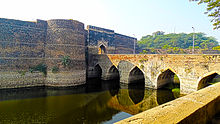
The
Travancore Kingdom
King
During
Mysore Kingdom
The first iron-cased and metal-cylinder
-
A painting showing the Mysorean army fighting the British forces with Mysorean rockets, which used metal cylinders to contain the combustion powder.[37]
-
AMysorean rocket as a flagstaff (Robert Home, 1793/4).
Sikh Empire
| Sikh Empire |
|---|
|
Maharaja
Ranjit Singh died in 1839, and his empire crumbled under internal strife and poor governance by his heirs. On the east of his realm
Colonial era
Company rule
The

During the Indian Rebellion of 1857, some units of the Bengal Native Infantry and Cavalry mutinied against the British East India Company. However, the rebels received less support than they had expected from members of the Bombay and Madras Armies. A number of atrocities were perpetrated by the rebels, most infamously at the Siege of Cawnpore. The rebellion ultimately failed because of lack of resources and coordination among the rebels. During their suppression of the rebellion, the British carried out numerous reprisals, and the revolt was largely quashed by 1858.[38]
The British Raj
| British Rule |
|---|
|
Following the Sepoy Mutiny, British rule in India was reorganised under the
After 1857, the Presidency armies were abolished in favour of a reconstituted British Indian Army under the control of the
The British Indian Army consisted of members of all the major religious groups in India: Hindus, Sikhs, Christians, and Muslims. The number of Sikhs in the army grew steadily with time as British commanders came to believe they were more loyal and martial, an impression reinforced by their conduct during the Sepoy Mutiny. The Sikhs, for their part, aligned with the British to prevent a resurgence of Mughal rule; Sikhs had been persecuted under the Mughal Empire.
The Indian Air Force was established in 1932.
World War I
During World War I, over 800,000 volunteered for the army, and more than 400,000 volunteered for non-combat roles, compared with the pre-war annual recruitment of about 15,000 men.[39] The Army saw action on the Western Front within a month of the start of the war, at the First Battle of Ypres where Khudadad Khan became the first Indian to be awarded a Victoria Cross. After a year of front-line duty, sickness and casualties had reduced the Indian Corps to the point where it had to be withdrawn. Nearly 700,000 Indians fought the Turks in the Mesopotamian campaign. Indian formations were also sent to East Africa, Egypt, and Gallipoli.[40]
Indian Army and
One million Indian troops served abroad during the war. In total, 74,187 died,[41] and another 67,000 were wounded.[42] The roughly 90,000 soldiers who lost their lives fighting in World War I and the Afghan Wars are commemorated by the India Gate.
World War II
In 1939, the British Indian Army's strength was about 189,000, with about 3,000 British officers and 1,115 Indian officers. The army was expanded greatly to fight in
During the war, Indian nationalist expatriates in Southeast Asia and the Japanese Army formed the Indian National Army (INA) to fight for Indian independence from Britain. For manpower, it relied on the approximately 45,000 Indian troops of the Indian Army whom the Japanese captured when Singapore fell in February 1942. Subhas Chandra Bose was parachuted in to lead the INA in 1943, and he greatly expanded the INA to include the mainly Tamil civilian Indian community in Malaya. He also negotiated a combat role for the INA from the reluctant Japanese, who were more inclined to use it intelligence and propaganda work. In 1944, INA units participated in the Japanese Army's offensives against British positions in the Arakan and the Imphal Plain. Not being a military man Bose – or "Netaji" (respected leader) naively believed that Indian soldiers of the Indian Army who deployed against the INA would flock to its standard. But these Indian troops stood fIrm, and actually defeated the INA. Despite this, Bose insisted that the INA be given an independent sector on the Irrawaddy in February 1945. Despite the desperate efforts of some INA troops, their sector was overrun, and desertions became commonplace. Militarily, the INA was finished. After the war, however, it made a political impact, due to the British decision to publicly court-martial three INA commanders. This was a miscalculation, because Indian nationalist politicians, who had previously come out against the INA, now whipped up popular sentiment for the release of the INA accused. Realizing their error, the British acquiesced. In this way, the INA was another sign that the Raj's days were numbered.
Post-war transition and the Dominion of India
At the end of the war in 1945, the Indian Army's officer corps included Indian Medical Service officer Hiraji Cursetji as its sole Indian major-general, one IMS brigadier, three Indian brigadiers in combatant arms and 220 other Indian officers in the temporary or acting ranks of colonel and lieutenant-colonel.
With Indian independence now a certainty and with a new Labour government recently elected in the UK, the Indianization of the armed forces continued to progress, though by June 1947, two months before independence, the Indian Army had only 14 Indian officers at the rank of brigadier serving in combatant arms, with no Indian flag, general or air officers in the combat arms of the armed services.[46]
Republic of India
Major wars
The Republic of India has fought four wars with Pakistan and one border war with China.
First Indo-Pakistani war, 1947

This is also called the First Kashmir War. The war started in October 1947 when Pakistan feared that the
Operation Polo, 1948
After the war with Pakistan, India turned its attention to the independent Hyderabad State. India perceived the nearby independent Muslim state and potential Pakistani ally as a threat. In a five-day operation, India reconquered and annexed Hyderabad.
Liberation of Goa, 1961
In 1961 tension rose between India and Portugal over the Portuguese-occupied territory of Goa, which India claimed for itself. After Portuguese police cracked down violently on a peaceful, unarmed demonstration for union with India, the Indian government decided to reconquer. A lopsided air, sea, and ground campaign resulted in the speedy surrender of Portuguese forces.[54] Within 36 hours, 451 years of Portuguese colonial rule was ended, and Goa was annexed by India. Portuguese losses were 34 killed, 57 wounded, and 3,306 captured. Indian losses were 22 killed and 51 wounded.[55]
Sino-Indian war, 1962
India fought a month-long border war against China in 1962. Neither nation deployed air or naval resources during a conflict heavy with mountain combat. China ended the war by declaring a unilateral ceasefire and withdrew their forces to the pre-war positions.[56]
The defeat prompted India to make major changes in its military. The Department of Defence Production was established to create an indigenous defence production base, which would be self-reliant and self-sufficient. Since 1962, 16 new ordnance factories have been built under the program.[citation needed]
Second Indo-Pakistani war, 1965
This war started following Pakistan's
Indo-Sino Clash of 1967
The 1967 Sino-Indian clash also known as the
The end of the battle saw the Chinese Army forced to leave Sikkim after being defeated by Indian troops.[70][71][72]
Third Indo-Pakistani war, 1971

This war was unique in the way that it did not involve the issue of Kashmir, but was rather precipitated by the crisis created by the political battle between Sheikh Mujib, Leader of East Pakistan and Yahya-Bhutto, leaders of West Pakistan brewing in erstwhile
Pakistan attacked at several places along India's western border with Pakistan, but the
Siachen war, 1984
In the late 1970s and early 1980s, Pakistan began organising tourist expeditions on the
Kargil War, 1999

Commonly known as the Kargil War, or Operation Vijay in India, this conflict between the two countries was mostly limited. During early 1999, Pakistani troops infiltrated across the Line of Control (LoC) and occupied Indian territory mostly in the Kargil district. India responded by launching a major military and diplomatic offensive to drive out the Pakistani infiltrators.[88] Two months into the conflict, Indian troops had slowly retaken most of the ridges that were encroached by the infiltrators.[89][90] According to official count, an estimated 75%–80% of the intruded area and nearly all high ground was back under Indian control.[91] Fearing large-scale escalation in military conflict, the international community, led by the United States, increased diplomatic pressure on Pakistan to withdraw forces from remaining Indian territory.[88][92] Faced with the possibility of international isolation, the already fragile
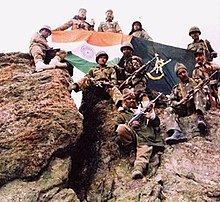
By the end of July 1999, organized hostilities in the Kargil district had ceased[92] and Kargil War finally came to end with a decisive Indian military and diplomatic victory.[103][104][105][106][107][108][109][110][111][53]
Other operations
The Mizo National Front, 1966
In March 1966, Mizo rebels in Assam declared independence and attacked government offices and military posts. The uprising was suppressed weeks later, and eventually Mizoram was made a separate state of India.
The Chola incident, 1967
A Sino-Indian skirmish known today as the
Operation Blue Star, 1984
In June 1984, then-Prime Minister Indira Gandhi ordered an attack on Sikh separatists belonging to the Khalistan movement who had holed up in the Golden Temple in Amritsar. The operation resulted in 500–1,500 civilian deaths and heavy damage to the Akal Takht.
Sri Lanka mission, 1987–1990
The
Operation Cactus, 1988

In November 1988, the
2001 Bangladesh–India border clashes
Also known as Bangladeshi-India border war, this brief war started on 15 April when Bangladeshis captured the disputed village of Pyrdiwah. The clashes lasted for about 5 days when the India and Bangladeshi forces took their original positions and the war ended in status quo ante bellum.
Missile program
India has well developed[
- Agni ballistic missile
- Prithvi ballistic missile
- Akash surface-to-air missile
- Trishul surface-to-air missile
- Nag anti-tank guided missile
- Nirbhay cruise missile
Currently the
Nuclear program
In 1974, India tested a nuclear weapon with a yield of up to 15
Recent developments
The Indian military ranks
Military collaborations with other countries

In 1997, India agreed to participate in the development of Russia's "Prospective Air Complex for Tactical Air Forces" program. One of the primary objectives of the program was to develop a 5th generation
India has focused recently on purchasing the technology behind military equipment rather than equipment itself. Recent examples include purchases of
Disasters
On 28 April 2000, ammunition worth ₹3.93 billion (US$49 million) was destroyed in a fire at the
Awards
India's highest awards for military conduct in a time of war are, in descending order, the
See also
- Indian Army Day
- History of India
- History of the Indian Navy
- Military history of India during World War II
- Military of India
- Ancient Hindu wars
Notes
References
- ^ "Aggressive architecture, Fortifications of the Indus valley in the Mature Harappan phase" (PDF). 31 August 2012.
- ^ "Expedition Magazine | The Mythical Massacre at Mohenjo-Daro". www.penn.museum. Retrieved 15 December 2018.
- ^ "Excavations-Dholavira". Archaeological Survey of India. Archived from the original on 3 September 2011. Retrieved 30 June 2012.
- ISBN 9781576079072.
- ^ "The faience of the Indus civilization" (PDF). opar.unior.it. Retrieved 25 December 2018.
- ^ "Sinauli village in UP becomes archaeological hotpost with excavation of 5000-year-old chariots". hindustantimes. 9 June 2018. Retrieved 25 December 2018.
- ^ "mahajanapadas.htm". history-of-india.net. Archived from the original on 6 March 2016. Retrieved 3 March 2017.
- ISBN 978-1783083497.
- ISBN 978-0-226-26436-3.
- ^ *1910,0403.26
- ^ Katariya, Adesh. Ancient History of Central Asia: Yuezhi-Gurjar History, Article No 01. Adesh Katariya. p. 16.
- ^ Chandragupta II controlled the whole
- ^ A Comprehensive History of Ancient India (3 Vol. Set) by P.N Chopra p.203
- ^ John Merci, Kim Smith; James Leuck (1922). "Muslim conquest and the Rajputs". The Medieval History of India pg 67–115
- ^ John Holland Rose; Arthur Percival Newton; Ernest Alfred Benians; Henry Dodwell (1929). The Cambridge History of the British Empire. CUP Archive. p. 14.
- ^ "Vijayanagara Research Project::Elephant Stables". Vijayanagara.org. 9 February 2014. Archived from the original on 17 May 2017. Retrieved 21 May 2018.
- ISBN 0-231-11004-9
- ^ K A Nilakanta Shastri History of South India pg267 Quote: "According to Shastri, the greatest factor was the betrayal of the Vijaynagara Army by two Muslim commanders (Gilani Brothers). At the critical point of the war, Muslim officers in the Vijayanagara army launched a subversive attack. Suddenly Rama Raya found himself surprised when the two Muslim divisions in his ranks turned against him"
- ^ "Ahom | people | Britannica.com". britannica.com. Retrieved 3 March 2017.
- ISBN 978-81-224-1198-0.
- ISBN 9780822386162.
- ISBN 978-81-269-0704-5.
- ^ "Mughal Empire". Archived from the original on 25 February 2008.
- ISBN 0521566037
- ^ "Religions – Islam: Mughal Empire (1500s, 1600s)". BBC. 7 September 2009. Retrieved 14 March 2012.
- ^ "Religions – Islam: Mughal Empire (1500s, 1600s)". BBC. 7 September 2009. Retrieved 14 March 2012.
- ^ Biddulph, Colonel John. The Pirates of the Malibar and an Englishwoman in India Two Hundred Years Ago. London: Smith, Elder & Co, 1907
- ^ "Regional states, c. 1700–1850". Encyclopædia Britannica, Inc. 27 January 2024.
- ISBN 978-1-84331-004-4.
- ISBN 978-81-7100-372-3.
- ISBN 81-224-1245-9.
- ISBN 978-93-80607-00-9.
- ^ Chandra, Satish (1990). Medieval India. India: National Council for Educational Research and Training. pp. Chapter 18 p. 295, 296.
- OCLC 1067771105. Retrieved 20 December 2019.
- ISBN 978-81-7099-136-6.
- ^ Seringapatamin 1792 and 1799 these rockets were used with considerable effect against the British." – Encyclopædia Britannica (2008), rocket and missile.
- ^ "Missiles mainstay of Pak's N-arsenal". The Times of India. 21 April 2008. Archived from the original on 24 September 2012. Retrieved 30 August 2011.
- ISBN 978-0-521-00254-7
- ^ Pati, p.31
- ^ "Participants from the Indian subcontinent in the First World War". Memorial Gates Trust. Retrieved 12 September 2009.
- ^ "Commonwealth War Graves Commission Annual Report 2007–2008 Online". Archived from the original on 26 September 2007.
- ^ Sumner, p.7
- ^ "Officers For India: Beginning of Big Changes". The Times. 30 May 1945.
- ^ "The Indian Forces: Gradual Elimination of European Officers". The Times. 23 October 1945.
- ^ "Million and a Quarter Demobilised From the Services" (PDF). Press Information Bureau of India – Archive. Retrieved 26 January 2019.
- ^ "British Troops in India: Reported Plans For Withdrawal". The Times. 17 June 1947.
- ^ Prasad, S.N.; Dharm Pal (1987). History of Operations in Jammu and Kashmir 1947–1948. New Delhi: History Department, Ministry of Defence, Government of India. (printed at Thomson Press (India) Limited). p. 418.
- ^
Hagerty, Devin (2005). South Asia in World Politics. Rowman & Littlefield. p. 161. ISBN 9780742525870.
- ^
The Kingfisher History Encyclopedia. Kingfisher. 2004. p. 460. ISBN 978-0-7534-5784-9.
- ^ a b New Zealand Defence Quarterly, Issues 24-29. New Zealand. Ministry of Defence. 1999.
- ^
Thomas, Raju (1992). Perspectives on Kashmir: the roots of conflict in South Asia. Westview Press. p. 25. ISBN 978-0-8133-8343-9.
- ISBN 978-1-109-04475-1.
- ^ ISBN 978-1-137-41235-5.
- ^ "Goa's Freedom Movement". Goacom.com. Archived from the original on 14 February 2012. Retrieved 14 March 2012.
- ISBN 978-1-935501-10-7.
- ISBN 978-1-57958-181-7.
- ISBN 978-1-57607-712-2.
- ^ "Pakistan :: The Indo-Pakistani War of 1965". Library of Congress Country Studies, United States of America. April 1994. Retrieved 2 October 2010. Quote: Losses were relatively heavy—on the Pakistani side, twenty aircraft, 200 tanks, and 3,800 troops. Pakistan's army had been able to withstand Indian pressure, but a continuation of the fighting would only have led to further losses and ultimate defeat for Pakistan.
- ISBN 0-7425-2587-2. Quote: The invading Indian forces outfought their Pakistani counterparts and halted their attack on the outskirts of Lahore, Pakistan's second-largest city. By the time the United Nations intervened on 22 September, Pakistan had suffered a clear defeat.
- ISBN 0520246969. Quote: India, however, was in a position to inflict grave damage to, if not capture, Pakistan's capital of the Punjab when the cease-fire was called, and controlled Kashmir's strategic Uri-Poonch bulge, much to Ayub's chagrin.
- ISBN 0788102796. Quote: India had the better of the war.
- ^ "Asia: Silent Guns, Wary Combatants". Time. 1 October 1965. Retrieved 30 August 2013. Quote: India, by contrast, is still the big gainer in the war. Alternate link: http://content.time.com/time/subscriber/printout/0,8816,834413,00.html
- ^ "Pakistan".
- ^ Speech of Bill McCollum Archived 4 March 2016 at the Wayback Machine in United States House of Representatives 12 September 1994
- ISBN 0-7425-2587-2, p. 26
- ISBN 978-0-7656-2766-7.
- ^ ISBN 978-81-7648-538-8.
- hdl:10603/30868.
- ^ "India-china Relationships: Reasons for China's Frequent Boder Intrusions & Options for Indian Response | SSBMADEEASY". ssbmadeeasy.com. Retrieved 3 March 2017.
- ISBN 9781137412355.
- ^ "50 years after Sino-Indian war". Millennium Post. 16 May 1975. Archived from the original on 3 December 2013. Retrieved 12 July 2013.
- ^ "Kirantis' khukris flash at Chola in 1967". Hindustan Times. Archived from the original on 26 April 2016. Retrieved 22 July 2015.
- ISBN 0-7146-8436-8.
- ISBN 9781843311492.
- ^ Times Staff and Wire Reports (30 March 2002). "Gen. Tikka Khan, 87; 'Butcher of Bengal' Led Pakistani Army". Los Angeles Times. Retrieved 30 October 2011.
- ^ Ahsan, Syed Badrul (15 July 2011). "A Lamp Glows for Indira Gandhi". The Daily Star. Retrieved 30 October 2011.
- ISBN 978-0-19-547697-2.
- ISBN 978-81-7024-752-4.
- ISBN 978-1-86064-898-4.
- ISBN 978-0-415-97662-6.
- ^ "The 1971 war". India – Pakistan:Troubled relations. BBC. Retrieved 30 October 2011.
- ISBN 0-14-02-2401-7.
- ISBN 9780312060671.
- ISBN 9780898865882.
- ^ Desmond/Kashmir, Edward W. (31 July 1989). "The Himalayas War at the Top of the World". Time.com. Archived from the original on 12 March 2007.
- ^ Easen, Nick (20 May 2002). "Siachen: The world's highest cold war". CNN. Retrieved 10 April 2006.
- ISBN 978-0804755504.
- ^ ISBN 9780520271401.
- ^ Ali, Tariq. "Bitter Chill of Winter". London Review of Books=. Archived from the original on 1 October 2009. Retrieved 20 May 2009.
- Chief of Army Staff VP Malik, expressing his views on Operation Vijay. Hosted on Daily Times; The Fate of Kashmir By Vikas Kapur and Vipin Narang Archived 18 January 2012 at the Wayback Machine Stanford Journal of International Relations; Book review of "The Indian Army: A Brief History by Maj Gen Ian Cardozo" Archived 8 January 2009 at the Wayback Machine– Hosted on IPCS
- ^ ISBN 9780275973087.
- ^ Samina Ahmed. "Diplomatic Fiasco: Pakistan's Failure on the Diplomatic Front Nullifies its Gains on the Battlefield" Archived 4 August 2011 at the Wayback Machine (Belfer Center for International Affairs, Harvard Kennedy School)
- ^ Daryl Lindsey and Alicia Montgomery. "Coup d'itat: Pakistan gets a new sheriff". salon.com. Archived from the original on 20 December 2009. Retrieved 19 June 2015.
- ^ "War in Kargil – The CCC's summary on the war" (PDF). Archived from the original (PDF) on 27 March 2009. Retrieved 20 May 2009.
- ^ Samina Ahmed. "A Friend for all Seasons." (Belfer Center for International Affairs, Harvard Kennedy School)
- ^ "Rediff on the NeT: Pakistan refuses to take even officers' bodies". rediff.com. Retrieved 19 June 2015.
- ^ "Press release issued in New Delhi regarding bodies of two Pakistan Army Officers". indianembassy.org. Archived from the original on 15 June 2010. Retrieved 3 March 2017.
- The Herald (Pakistan), July 2000. Online scanned version of the article Archived 21 July 2011 at the Wayback Machine
- ^ Musharraf and the truth about Kargil[usurped] – The Hindu 25 September 2006
- ^ "Over 4000 soldier's killed in Kargil: Sharif". The Hindu. Archived from the original on 11 November 2012. Retrieved 20 May 2009.
- ISBN 978-0804755498.
- ISBN 978-0-275-97308-7.
- ISBN 978-0-7546-7541-9.
- ISBN 978-0-8157-2492-6.
- ISBN 978-0-275-97308-7.
- ISBN 978-1-4289-8261-1. Retrieved 19 February 2016.
- ISBN 978-1-78004-757-7.
- ISBN 978-81-7099-890-7.
- ISBN 978-0-230-10938-4.
- ISBN 978-0-520-23210-5.
- ^ "Development of Ballistic Missile Defence System: Year End Review" (Press release). Ministry of Defence (India). 28 December 2007. Retrieved 26 January 2008.
- ^ "Forces gung-ho on N-arsenal". The Times of India. Archived from the original on 21 May 2013. Retrieved 21 July 2012.
Sources
- Grainger, John D. (2014), Seleukos Nikator: Constructing a Hellenistic Kingdom, Routledge, ISBN 978-1-317-80099-6
- ISBN 978-0-674-72882-0
- ISBN 81-208-0433-3
- Rehman, Abdur (January 1976). The Last Two Dynasties of the Sahis: An analysis of their history, archaeology, coinage and palaeography (Thesis). Australian National University.
- Trautmann, Thomas (2015), Elephants and Kings: An Environmental History, University of Chicago Press, ISBN 978-0-226-26453-0
- Wheatley, Pat; Heckel, Waldemar (2011), ""Commentary (Book 15)"", Justin: Epitome of the Philippic History of Pompeius Trogus: Volume II, Oxford University Press, ISBN 978-0-19-927759-9
Further reading
- Cohen, Stephen P. and Sunil Dasgupta, eds. Arming Without Aiming: India's Military Modernization (2010) excerpt and text search
- Davis, Zachary S. The India-Pakistan Military Standoff: Crisis and Escalation in South Asia (2011) excerpt and text search; focus on 2000–01 confrontation
- Deshpande, Anirudh. British Military Policy in India, 1900–1945: Colonial Constraints and Declining Power (2005)
- Holmes, James R. et al. Indian Naval Strategy in the Twenty-first Century (2009) excerpt and text search
- Khan, Iqtidar Alam. Gunpowder and Firearms: Warfare in Medieval India (2004)
- Marston, Daniel P. and Chandar S. Sundaram. A Military History of India and South Asia: From the East India Company to the Nuclear Era (2006)
- Roy, Kaushik. From Hydaspes to Kargil: A History of Warfare in India from 326 BC to AD 1999 (2004)
- Roy, Kaushik. The Oxford Companion to Modern Warfare in India (2009)
- Sandhu, Gurcharn Singh. Military History of Medieval India (2003)
- Subramaniam, Arjun. India's Wars: A Military History, 1947–1971 (2017), 576 pages. ISBN 978-1-68247-241-5
- Sundaram, Chandar S., 'Warfare—South Asia', in W.H. McNeill and P. Stearns, eds., The Berkshire Encyclopaedia of World History 2005, vol. 5, pp. 1991–6, (2005)
- Sundaram, Chandar S., "A Paper Tiger: the Indian National Army in battle, 1944–1945", War & Society, 13(1), pp. 35–59 (1995)
- Jadunath Sarkar (1970). Military history of India. Bombay: Orient Longmans.
- Thapliyal, Uma Prasad. Warfare in Ancient India: Organizational and Operational Dimensions (2010)
Official war histories
Official war histories written by the History Division, Ministry of Defence, Government of India:
External links
- The Irrelevance of India's Rise as a Military Power- video of lecture by Stephen P. Cohen, Brookings Institution, hosted by the Program in Arms Control, Disarmament, and International Security (ACDIS), University of Illinois, 15 October 2009
- Notes
- The Role of Muslims Martial Races of Today: Pakistan in British-Indian Army in World War-II by Brig (Retd) Noor A Husain.
- India Defence- Defence And Military Portal
- Indian Jawan- A Tribute to the Indian Soldier
- Indian army history
- Indian Air Force history
- Indian Air Force History (Bharat-Rakshak.com)
- Soldiers of the British and Indian armies 1840 to 1920
- Anne S. K. Brown Military Collection, Brown University Library Military history and graphics, c. 1790 – 1918



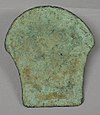
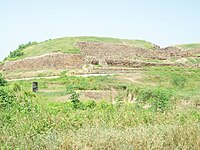








![A depiction of a British naval attack in 1755 against the Maratha Navy at Suvarnadurg.[27]](http://upload.wikimedia.org/wikipedia/commons/thumb/f/f5/Francis_Holman%2C_Commodore_James_in_the_Protector%2C_with_the_Revenge_and_the_grab_Bombay_in_the_bay_off_the_fort_at_Gheriah%2C_India%2C_April_1755_%2818th_century%29.jpg/120px-Francis_Holman%2C_Commodore_James_in_the_Protector%2C_with_the_Revenge_and_the_grab_Bombay_in_the_bay_off_the_fort_at_Gheriah%2C_India%2C_April_1755_%2818th_century%29.jpg)

![A painting showing the Mysorean army fighting the British forces with Mysorean rockets, which used metal cylinders to contain the combustion powder.[37]](http://upload.wikimedia.org/wikipedia/commons/thumb/c/c6/Rocket_warfare.jpg/180px-Rocket_warfare.jpg)






